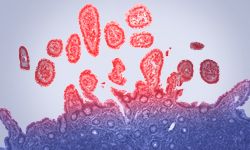Long-term S1106 Trial Data Support Rituximab-Bendamustine Combo in Pre-Transplant MCL
Five-year outcomes data from the S1106 phase II trial in patients with newly diagnosed mantle cell lymphoma found that the RB regimen was equally effective but less toxic than the RH regimen. <br />

Five-year outcomes data from the S1106 phase II trial in patients with newly diagnosed mantle cell lymphoma (MCL) found that the RB regimen (rituximab [Rituxan] plus bendamustine [Bendeka]) was equally effective but less toxic than the RH regimen (R-hyper-CVAD [rituximab plus hyperfractionated cyclophosphamide, vincristine, doxorubicin, and dexamethasone] plus methotrexate/cytarabine).1
The 5-year progression-free survival (PFS) rate for RB was 66% (95% CI, 45%-80%), while the 5-year overall survival (OS) rate was 80% (95% CI, 62%-91%). Patients who received the RH regimen had a 5-year PFS rate of 62% (95% CI, 34%-81%) and a 5-year OS rate of 74% (95% CI, 44%-89%).
“Five-year follow-up of S1106 demonstrates similar efficacy, MRD [minimal residual disease] negativity, and 5-year survival with RH or RB, but RH was more toxic than RB,” wrote the study authors, led by Manali Kamdar, MD, of the University of Colorado, in the report published inBlood Advances. “RB showed excellent efficacy and survival and less toxicity compared with a cytarabine-based regimen in transplant-eligible [patients with] MCL.”
S1106 was a randomized, multi-institutional clinical trial that evaluated the potential of RB as a pre-transplant induction regimen in MCL. Following induction with either RB or RH, patients then received autologous stem cell transplant (ASCT). Previously published data indicated that the primary end point of 2-year PFS and the secondary end point of OS were similar regardless of the regimen.2
However, the study was closed early due to RH’s increased toxicity and higher stem cell mobilization failure rates. “We demonstrated for the first time in a prospective setting that outpatient RB treatment can achieve excellent MRD negativity and could serve as an induction strategy worthy of further study,” Kamdar et al wrote. “Given the increased survival of MCL patients, critical assessment of long-term efficacy and toxicity is needed.”
All but one of S1106’s 53 patients were evaluable (17 RH and 35 RB). Baseline characteristics were similar between the two groups. More than 90% of patients in both arms had stage IV extranodal disease and bone marrow involvement. A total of 9 out of 17 patients in the RH arm and 23 out of 35 patients in the RB arm ultimately completed ASCT.
Kamdar et al performed a landmark analysis at the 5-year mark with and without ASCT in each arm to estimate the time-to-event probabilities in each group. In the RH arm, the 5-year landmark PFS estimate for patients undergoing ASCT versus those who did not was 50% (95% CI, 15%-77%) versus 73% (95% CI, 28%-93%;P= .34), respectively. The 5-year landmark OS rate was 75% (95% CI, 31%-93%) versus 73% (95% CI, 28%-93%;P= .81), respectively.
In the RB arm, the 5-year landmark PFS estimates for patients undergoing ASCT versus those who did not were 70% (95% CI, 43%-86%) versus 63% (95% CI, 23%-86%;P= .44), respectively. The 5-year landmark OS rate in this group was 91% (95% CI 69% to 98%) versus 60% (95% CI, 20%-85%;P= .055), respectively.
“The updated 5-year landmark OS estimates continue to suggest that the ASCT benefit is greater in patients receiving induction RB, although the limited sample size precludes definitive conclusions,” the authors wrote.
Additionally, Kamdar et al noted that the comparison was underpowered due to the early closure of the RH arm.
Ten of the 52 evaluable patients had died at the time of publication, 4 in the RH group and 6 in the RB group. Disease progression was the leading cause of death (n = 6). Two patients developed second malignancies. One patient in the RH arm who did not receive ASCT was diagnosed with acute myelogenous leukemia at 5.4 years after diagnosis and remained alive. And one patient in the RB arm who did receive ASCT developed lung cancer at 2.9 years after diagnosis and subsequently died.
Kamdar et al note that their work has inspired the Eastern Cooperative Oncology Group to design EA4181, a randomized 3-arm phase II trial to test a bendamustine-based induction chemotherapy backbone with cytarabine and/or a BTK-inhibitor in patients with untreated MCL.3
References
- Kamdar M, Li H, Chen RW, et al. Five-year outcomes of the S1106 study of R-hyper-CVAD vs R-bendamustine in transplant-eligible patients with mantle cell lymphoma [published online October 22, 2019].Blood Advances. 2019;3(20):3132-3135.
- Chen RW, Li H, Bernstein SH, et al. RB but not R-HCVAD is a feasible induction regimen prior to auto-HCT in frontline MCL: results of SWOG Study S1106.Br JHaematol. 2017;176(5):759-769. doi: 10.1111/bjh.14480.
- EA4181 Physician Fact Sheet. Eastern Cooperative Oncolcogy Group website. http://ecog-acrin.org/wp-content/uploads/2019/10/EA4181-physician-fact-sheet.pdf. Accessed November 18, 2019.